doing 作定语和状语
- 格式:ppt
- 大小:73.00 KB
- 文档页数:10
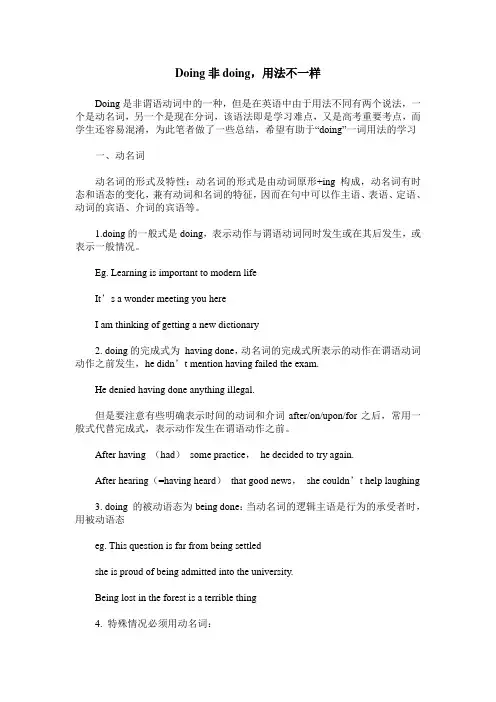
Doing非doing,用法不一样Doing是非谓语动词中的一种,但是在英语中由于用法不同有两个说法,一个是动名词,另一个是现在分词,该语法即是学习难点,又是高考重要考点,而学生还容易混淆,为此笔者做了一些总结,希望有助于“doing”一词用法的学习一、动名词动名词的形式及特性:动名词的形式是由动词原形+ing 构成,动名词有时态和语态的变化,兼有动词和名词的特征,因而在句中可以作主语、表语、定语、动词的宾语、介词的宾语等。
1.doing的一般式是doing,表示动作与谓语动词同时发生或在其后发生,或表示一般情况。
Eg. Learning is important to modern lifeIt’s a wonder meeting you hereI am thinking of getting a new dictionary2. doing的完成式为having done,动名词的完成式所表示的动作在谓语动词动作之前发生,he didn’t mention having failed the exam.He denied having done anything illegal.但是要注意有些明确表示时间的动词和介词after/on/upon/for之后,常用一般式代替完成式,表示动作发生在谓语动作之前。
After having (had)some practice,he decided to try again.After hearing(=having heard)that good news,she couldn’t help laughing3. doing 的被动语态为being done:当动名词的逻辑主语是行为的承受者时,用被动语态eg. This question is far from being settledshe is proud of being admitted into the university.Being lost in the forest is a terrible thing4. 特殊情况必须用动名词:1)动名词做宾语:有些动词或短语动词后常用动名词作宾语。
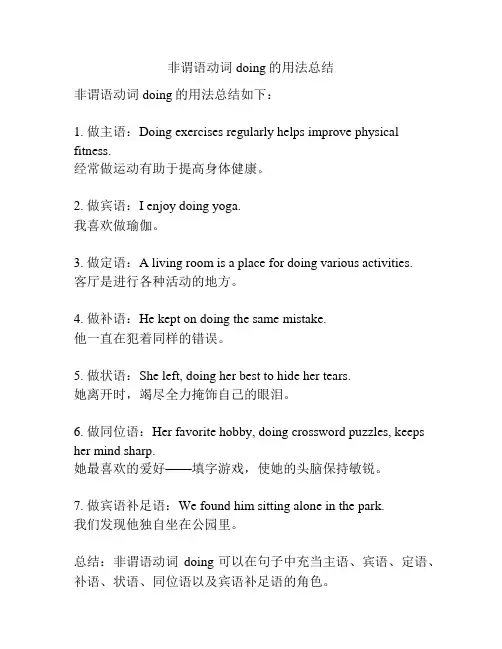
非谓语动词doing的用法总结
非谓语动词doing的用法总结如下:
1. 做主语:Doing exercises regularly helps improve physical fitness.
经常做运动有助于提高身体健康。
2. 做宾语:I enjoy doing yoga.
我喜欢做瑜伽。
3. 做定语:A living room is a place for doing various activities.
客厅是进行各种活动的地方。
4. 做补语:He kept on doing the same mistake.
他一直在犯着同样的错误。
5. 做状语:She left, doing her best to hide her tears.
她离开时,竭尽全力掩饰自己的眼泪。
6. 做同位语:Her favorite hobby, doing crossword puzzles, keeps her mind sharp.
她最喜欢的爱好——填字游戏,使她的头脑保持敏锐。
7. 做宾语补足语:We found him sitting alone in the park.
我们发现他独自坐在公园里。
总结:非谓语动词doing可以在句子中充当主语、宾语、定语、补语、状语、同位语以及宾语补足语的角色。
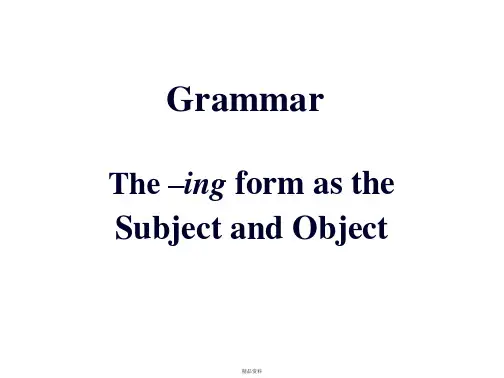
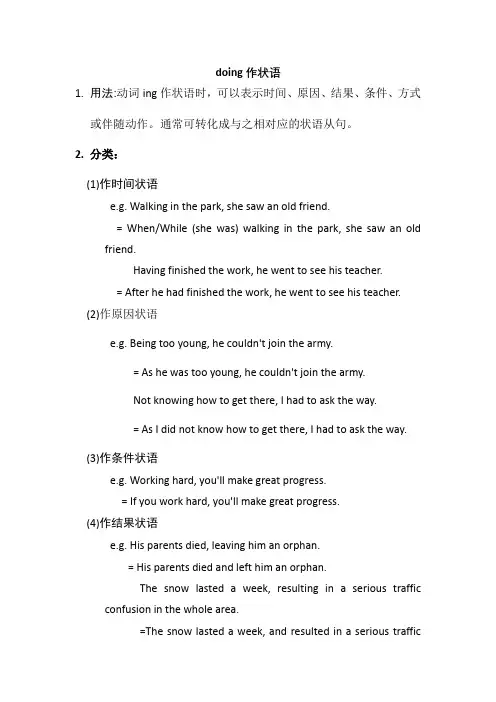
doing作状语1.用法:动词ing作状语时,可以表示时间、原因、结果、条件、方式或伴随动作。
通常可转化成与之相对应的状语从句。
2.分类:(1)作时间状语e.g. Walking in the park, she saw an old friend.= When/While (she was) walking in the park, she saw an old friend.Having finished the work, he went to see his teacher.= After he had finished the work, he went to see his teacher.(2)作原因状语e.g. Being too young, he couldn't join the army.= As he was too young, he couldn't join the army.Not knowing how to get there, I had to ask the way.= As I did not know how to get there, I had to ask the way.(3)作条件状语e.g. Working hard, you'll make great progress.= If you work hard, you'll make great progress.(4)作结果状语e.g. His parents died, leaving him an orphan.= His parents died and left him an orphan.The snow lasted a week, resulting in a serious traffic confusion in the whole area.=The snow lasted a week, and resulted in a serious trafficconfusion in the whole area.注意:动词ing形式与不定式均可作结果状语,区别是:动词ing 形式表示顺其自然、意料之中的结果,而不定式则表示不愿看到的、出人意料的结果。
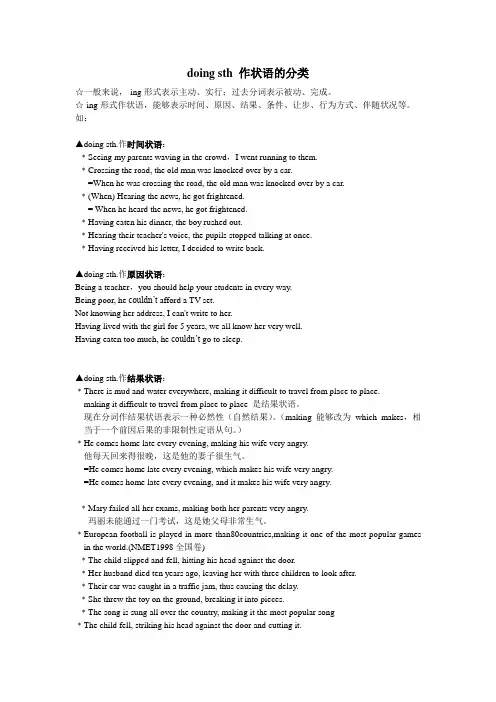
doing sth 作状语的分类☆一般来说,-ing形式表示主动、实行;过去分词表示被动、完成。
☆-ing形式作状语,能够表示时间、原因、结果、条件、让步、行为方式、伴随状况等。
如:▲doing sth.作时间状语:﹡Seeing my parents waving in the crowd,I went running to them.﹡Crossing the road, the old man was knocked over by a car.=When he was crossing the road, the old man was knocked over by a car.﹡(When) Hearing the news, he got frightened.= When he heard the news, he got frightened.﹡Having eaten his dinner, the boy rushed out.﹡Hearing their teacher's voice, the pupils stopped talking at once.﹡Having received his letter, I decided to write back.▲doing sth.作原因状语:Being a teacher,you should help your students in every way.Being poor, he couldn’t afford a TV set.Not knowing her address, I can't write to her.Having lived with the girl for 5 years, we all know her very well.Having eaten too much, he couldn’t go to sleep.▲doing sth.作结果状语:﹡There is mud and water everywhere, making it difficult to travel from place to place.making it difficult to travel from place to place 是结果状语。
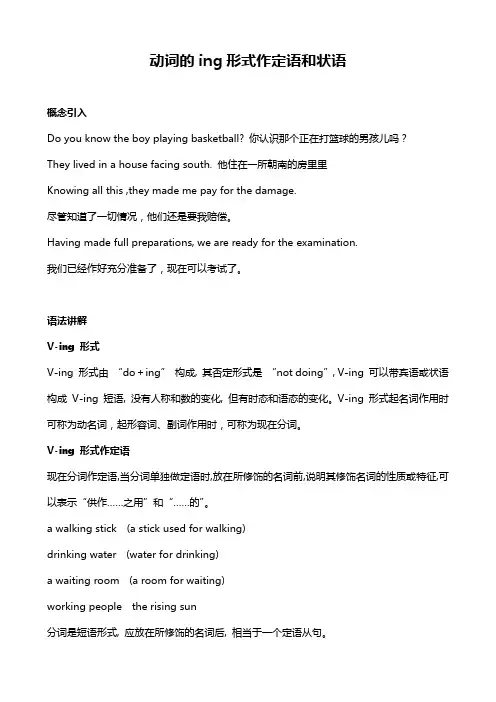
动词的ing形式作定语和状语概念引入Do you know the boy playing basketball? 你认识那个正在打篮球的男孩儿吗?They lived in a house facing south. 他住在一所朝南的房里里Knowing all this ,they made me pay for the damage.尽管知道了一切情况,他们还是要我赔偿。
Having made full preparations, we are ready for the examination.我们已经作好充分准备了,现在可以考试了。
语法讲解V-ing 形式V-ing 形式由“do+ing”构成, 其否定形式是“not doing”, V-ing 可以带宾语或状语构成V-ing 短语, 没有人称和数的变化, 但有时态和语态的变化。
V-ing 形式起名词作用时可称为动名词,起形容词、副词作用时,可称为现在分词。
V-ing 形式作定语现在分词作定语,当分词单独做定语时,放在所修饰的名词前,说明其修饰名词的性质或特征,可以表示“供作……之用”和“……的”。
a walking stick (a stick used for walking)drinking water (water for drinking)a waiting room (a room for waiting)working people the rising sun分词是短语形式, 应放在所修饰的名词后, 相当于一个定语从句。
They are visitors coming from several countries.who come from several countries.Three days later I received a letter offering me the job.which offered me the job.The girl standing there is my classmate.who stands there现在分词作状语现在分词作状语时, 分词的逻辑主语必须是句子的主语, 分词必须和句中的主语含有逻辑上的主谓关系, 否则不能用现在分词作状语。


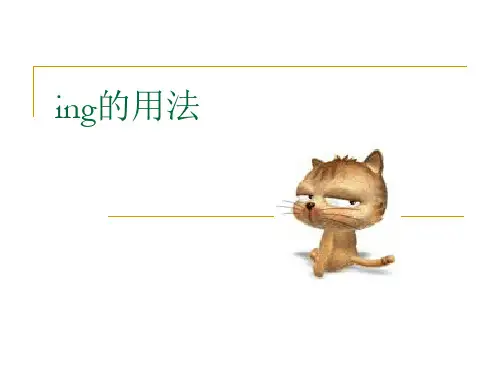
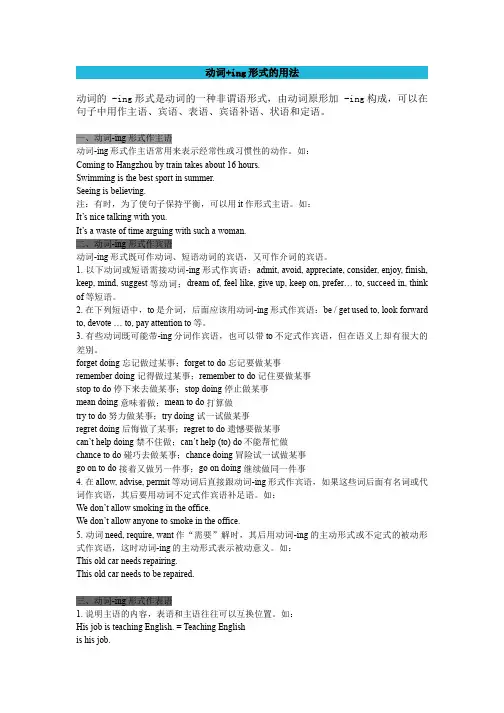
动词+ing形式的用法动词的 -ing形式是动词的一种非谓语形式,由动词原形加 -ing构成,可以在句子中用作主语、宾语、表语、宾语补语、状语和定语。
一、动词-ing形式作主语动词-ing形式作主语常用来表示经常性或习惯性的动作。
如:Coming to Hangzhou by train takes about 16 hours.Swimming is the best sport in summer.Seeing is believing.注:有时,为了使句子保持平衡,可以用it作形式主语。
如:It’s nice talking with you.It’s a waste of time arguing with such a woman.二、动词-ing形式作宾语动词-ing形式既可作动词、短语动词的宾语,又可作介词的宾语。
1. 以下动词或短语需接动词-ing形式作宾语:admit, avoid, appreciate, consider, enjoy, finish, keep, mind, suggest等动词;dream of, feel like, give up, keep on, prefer… to, succeed in, think of等短语。
2. 在下列短语中,to是介词,后面应该用动词-ing形式作宾语:be / get used to, look forward to, devote … to, pay attention to等。
3. 有些动词既可能带-ing分词作宾语,也可以带to不定式作宾语,但在语义上却有很大的差别。
forget doing 忘记做过某事;forget to do 忘记要做某事remember doing 记得做过某事;remember to do 记住要做某事stop to do 停下来去做某事;stop doing 停止做某事mean doing 意味着做;mean to do 打算做try to do 努力做某事;try doing 试一试做某事regret doing 后悔做了某事;regret to do 遗憾要做某事can’t help doing 禁不住做;can’t help (to) do不能帮忙做chance to do 碰巧去做某事;chance doing 冒险试一试做某事go on to do 接着又做另一件事;go on doing 继续做同一件事4. 在allow, advise, permit等动词后直接跟动词-ing形式作宾语,如果这些词后面有名词或代词作宾语,其后要用动词不定式作宾语补足语。

doing,主谓宾,adj作状语句型
"doing" 在英语中通常用作动词的现在分词形式,它可以作为句子的主语、谓语、宾语或状语。
以下是一些示例:
1. 主语:Doing exercise is good for your health.
2. 谓语:I am doing my homework.
3. 宾语:She likes doing yoga.
4. 状语:Doing the dishes, she sang a happy song.
主谓宾是英语中最基本的句子结构。
一个简单句通常由主语(subject)、谓语(verb)和宾语(object)组成。
例如:
主谓宾结构:I (主语) love (谓语) you (宾语).
形容词作状语通常用来描述动词或整个句子的状态或性质。
例如:
She walked quickly, anxious to arrive at the party.
在这个句子中,“quickly”是形容词,用作状语,描述了“walked”这个动作的方式。
而“anxious”是形容词,用作状语,描述了“she”这个主语的状态。
动词ing和不定式用法在英语学习中,动词 ing 和不定式的用法是一个重要且常让人感到困惑的部分。
理解它们的正确用法对于准确表达意思、构建流畅的句子至关重要。
首先,让我们来看看动词 ing 形式。
动词 ing 形式在句子中可以充当多种成分。
作主语时,它常常表示一般性的、习惯性的动作或状态。
比如,“Swimming is good for your health”(游泳对你的健康有益。
)这里的“swimming”就是一个主语,表示游泳这个整体的活动。
作宾语时,常见的动词后面会接动词 ing 形式。
比如,“I enjoy reading books”(我喜欢读书。
)“enjoy”这个动词后面就需要接动词 ing 形式“reading”。
作定语时,动词 ing 形式可以修饰名词,表示正在进行或主动的动作。
例如,“The sleeping baby is so cute”(那个正在睡觉的宝宝太可爱了。
)“sleeping”修饰“baby”,表示宝宝正在睡觉的状态。
作状语时,它可以表示时间、原因、条件、结果等。
比如说,“Seeing from the top of the mountain, we can have a wonderful view”(从山顶看,我们能看到美妙的景色。
)“Seeing from the top of the mountain”在这里是一个时间状语,表示“当从山顶看的时候”。
接下来,我们再看看不定式。
不定式作主语时,通常表示具体的、一次性的动作。
例如,“To learn a foreign language well is not easy”(学好一门外语不容易。
)作宾语时,有些动词要求接不定式。
比如,“I want to go home”(我想回家。
)“want”后面就接了不定式“to go”。
作定语时,不定式通常表示将要发生的动作。
例如,“I have a lot of work to do”(我有很多工作要做。
现在分词 (V-ing)作定语和状语课前预习案学习建议:根据所列例句,理解并尝试总结现在分词在句子中的用法。
动词 --ing形式作定语和状语I.ing形式作定语1.现在分词作前置定语时,在逻辑上与所修饰的名词之间为主谓关系,也可改成定语从句;如果与所修饰的名词之间没有主谓关系,定语相当于一个介词for 引导的短语。
现在分词位于所修饰的名词之后做后置定语,与所修饰的名词之间呈逻辑上的主谓关系,相当于一个定语从句。
如:a listening child= a childwho is listening, a walking stick= a stick for walking.2.现在分词作定语往往表示“令人⋯⋯” ,主动的或正在进行的动作。
如: a moving film, a developing country.II. ing形式作状语动词-ing 形式在句子中做状语,表示的动作是主语动作的一部分,与谓语动词表示的动作或状态是同时或者几乎同时发生的,经常可以做时间、原因、方式、条件、结果、目的、让步状语从句。
句子的主语必须是状语的逻辑主语;而且主语与作状语的分词之间呈逻辑上的主谓关系。
1.原因状语,相当于原因状语从句。
1).Being ill, she didn’t go to school today.因为生病,她今天没上学去。
2). Seeing no one at home, I decided to come again.看见没有人在家,我决定再来一趟。
2.时间状语,相当于 when, while 等引导的从句。
1).Hearing the good news, he jumped with joy.当听到这个好消息时,他高兴地跳了起来。
2).Walking in the street, I saw a friend of mine.当我走在街上时,我看到了我的朋友。
如果分词短语表示的动作与谓语表示的动作同时发生,常在分词短语前加上when或 while 。
doing开头的状语从句Doing出现在句首的状语从句主要有时间、原因和方式三种情况。
接下来我将分别从这三个方面进行回答,以回答超过1200字的要求。
首先是时间状语从句。
时间状语从句用来描述动作发生的具体时间或时间段。
以doing开头的时间状语从句通常可以使用现在分词(doing)或过去分词(done)。
下面是一些例子:1. Doing my homework, I suddenly realized it was already midnight.(做作业时,我突然意识到已经是午夜了。
)2. Doing some shopping, she bumped into an old friend.(逛街时,她遇到了一个老朋友。
)3. Doing our daily exercise, we enjoy the fresh air in the morning.(做我们的日常运动时,我们享受着早晨的新鲜空气。
)4. Doing some research, they discovered a new species of bird.(做研究时,他们发现了一种新的鸟类。
)接下来是原因状语从句。
原因状语从句用来解释一个动作或情况发生的原因。
以doing开头的原因状语从句通常使用动名词(doing)或不定式(to do)。
以下是一些例子:1. Doing his best to prepare for the exam, he ended up getting the highest score in the class.(为了准备考试,他尽了最大的努力,结果得了班级最高分。
)2. Doing something new always brings him a sense of excitement and adventure.(做一些新鲜的事情总是让他感到兴奋和充满冒险。
)3. Doing what he loved, he found his true calling in life.(做他喜欢的事情,他找到了他真正的人生使命。